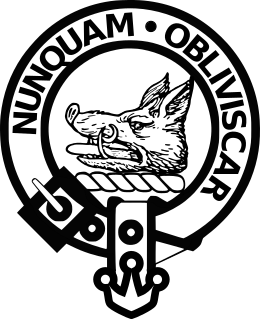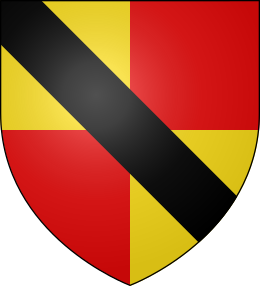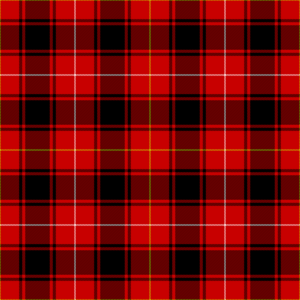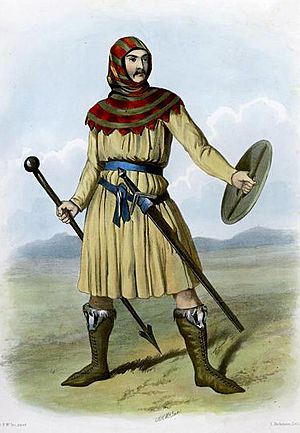Clan MacIver facts for kids
Quick facts for kids Clan MacIver |
|
|---|---|
| MacÌomhair | |

Crest: a boar's head couped Or
|
|
| Motto | nunquam obliviscar ("i will never forget") |
 |
|
| Clan MacIver has no chief, and is an armigerous clan | |
Clan MacIver, also known as Clan MacIvor or Clan Iver, is a Scottish clan. A clan is like a large family group in Scotland. This clan is recognized by the Lord Lyon King of Arms, who is the official in charge of Scottish heraldry (coats of arms and clan symbols). However, Clan MacIver does not have a recognized leader, called a 'chief'. This means it's an armigerous clan – a clan with its own coat of arms but no official chief.
The name MacIver comes from an old Gaelic word, which itself came from an Old Norse (Viking) name. Different spellings like MacGiver are also linked to bigger Scottish clans, like Clan Campbell and Clan Mackenzie. These different spellings are called "sept names," meaning they are followers or members of those larger clans. Today, there is a Clan Iver society in Fife, Scotland, for people interested in the clan's history.
Contents
What Does the Name MacIver Mean?
The name MacIver is an English version of the Gaelic name MacÌomhair. This Gaelic name means "son of Ìomhair." The personal name Ìomhair comes from the Old Norse word Ivarr. One of the earliest people recorded with the name MacIver was Malcolm McIuyr. He appeared on a list of men in a place called Argyll/Lorne in 1292.
The Clan's Beginnings and Confusion
It's probably not true that all people named MacIver come from the same original family. A historian named Alastair Campbell of Airds believes that a Victorian-era writer, Principal P. C. Campbell, made things confusing with his book Account of the Clan Iver. Principal Campbell was trying to get the Lord Lyon King of Arms to recognize him as the "Chief of Clan Iver." But he didn't succeed.
According to Campbell of Airds, the idea of a single "modern Clan MacIver" is also tricky. This is because it tries to include all MacIvers, no matter where their families originally came from. He suggests it's like a "modern game of clan-constructing."
Principal Campbell thought the MacIvers started in Glenlyon and moved to Argyll in 1222. Another artist, R. R. McIan, believed the MacIvers were related to the Campbells. He thought they came from Duncan, Lord of Lochow, who was an ancestor of the Campbells. Legend says that an old fort called Dun Mor (Dunmore), near Lochgilphead, was once a stronghold for the MacIvers.
An old family history book, Ane Accompt of the Genealogie of the Campbells, says that the first Iver was one of two sons of Colin Maol Math. Iver's mother was supposedly the daughter of Suibhne, who built Castle Sween. Suibhne is also thought to be the ancestor of Clan Sweeney.
The MacIver-Campbells
The most important family of the MacIver Campbells were the MacIvers of Lergachonzie and Stronshira. Some MacIvers were even the Captains of Inveraray Castle. A special standing stone at the castle was said to mark the border between the lands of the MacIvers and the MacVicars. Other MacIver Campbell families included those from Ballochyle, Kirnan, Pennymore, and Ardlarach.
Principal Campbell himself belonged to the Campbells of Quoycrook in Caithness. They claimed to be descendants of the MacIvers of Lergachonzie. Campbell also said that related families were the Campbells of Duchernan, the Campbells of Thurso and Lochend, and the Iverachs of Wideford in Orkney. Interestingly, the coats of arms for the Iverachs and Campbells of Duchernan look similar to the Campbell family's coat of arms.
In 1564, Iver MacIver of Lergachonzie made an agreement with Archibald Campbell, 5th Earl of Argyll. The Earl agreed to give up certain rights over the MacIvers in exchange for money. After this agreement, many MacIvers started using the name Campbell or MacIver-Campbell.
In 1680, some men from Clan MacIver in Argyll, who were part of Clan Campbell, joined with MacIvers from Caithness. They supported Sir John Campbell of Glenorchy in a fight against George Sinclair of Keiss. This fight, called the Battle of Altimarlach, was about who should be the Earl of Caithness. Campbell won the battle, but Sinclair later won the title through legal means. Even though the MacIvers were a small part of Campbell's force, they helped a lot. It's said that the clan's piper, Finlay MacIver, created a famous bagpipe tune called Bodach-na-briogais after the battle. Some also say he composed The Campbells Are Coming.
Northern Macivers
Macivers in Wester Ross
According to the stories of the Clan Mackenzie, there was a group of Macivers in Wester Ross, across the water from Lewis. An old writer, George Mackenzie, mentioned these families. He claimed that the 'MacIvors' and other clans were the original people of Kintail and came from Norwegian families.
The Macivers of Wester Ross are also linked to the Battle of Bealach nam Broig, which means "battle of the pass of the brogue." This battle happened around 1452 between different clans from Ross and the followers of the Earl of Ross. An early 17th-century writer, Robert Gordon, said that the Ross clans included "Clan-juer" (Clan-iver). Gordon wrote that these clans were "utterly extinguished and slain" by the Clan Munro and Dingwalls at this battle.
Macivers in Lewis
In the early 1900s, historian William C Mackenzie noted that a book from 1750 said the main people living on the Isle of Lewis were Morrisons, McAulays, and MacIvers. But when they left home, anyone living under the Earl of Seaforth (who was a Mackenzie) called themselves Mackenzies. Mackenzie thought that most of the Lewis Macivers probably settled on the island when the Mackenzies took control in the early 1600s.
As tenants of the Earl of Seaforth, the people of Lewis followed Clan Mackenzie. When William Mackenzie, 5th Earl of Seaforth supported the Jacobites in the 1715 Jacobite rising, he made a list of officers for his troops. This list included 16 men from Lewis, and two of them were MacIvers: Lieutenant Kenneth Maciver from Bragar and Ensign S. Maciver from Callanish.
Clan Symbols Today

Today, members of Scottish clans can show their loyalty by wearing a Scottish crest badge. These badges usually show the clan chief's heraldic crest and motto inside a strap and buckle design. This tradition started in the Victorian era. The crest badge for Clan MacIver has the Latin motto nunquam obliviscar, which means "I will never forget." The crest shows a boar's head couped Or (a gold boar's head cut off cleanly). Both the crest and motto are very similar to those of the chief of Clan Campbell, the Duke of Argyll. The MacIver motto actually seems to be an answer to the Campbell chief's motto.
There isn't much old evidence for the MacIver tartan. It is believed to be a fairly new design. The MacIver tartan looks very similar to the Clan Macfie tartan.
Clan Castle
- Glendarroch is a place about two miles southwest of Lochgilphead in Argyll. It is also known as the Robber's Den and Kilduskland. This site is naturally protected by deep gorges on two sides and also has a man-made ditch cut into the rock. There are also the remains of two old buildings. It is said to have been a hiding place for bandits and was supposedly used by the MacIvers in the 1600s.
See also
- Clan Campbell, a clan closely related to the MacIver-Campbells.
- Thomas Campbell, a famous poet who was from the MacIver-Campbells.
- Colin Campbell, 1st Baron Clyde, a military leader who was born Colin MacIver.


